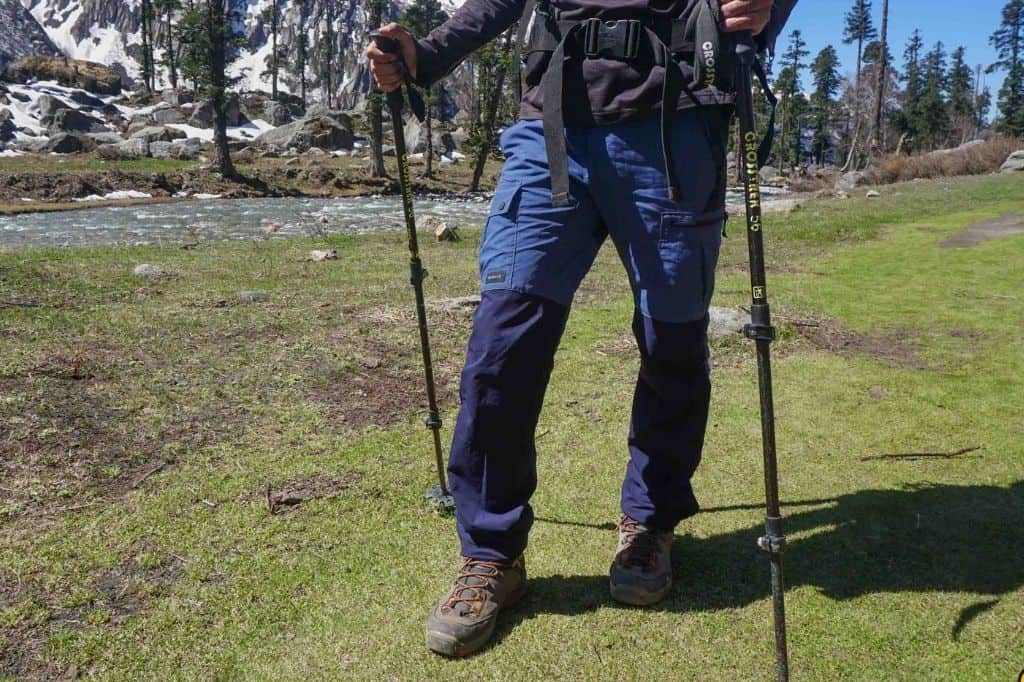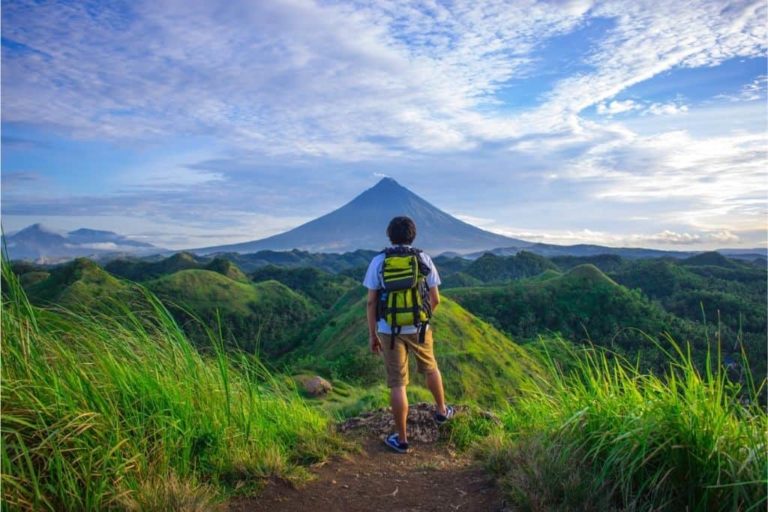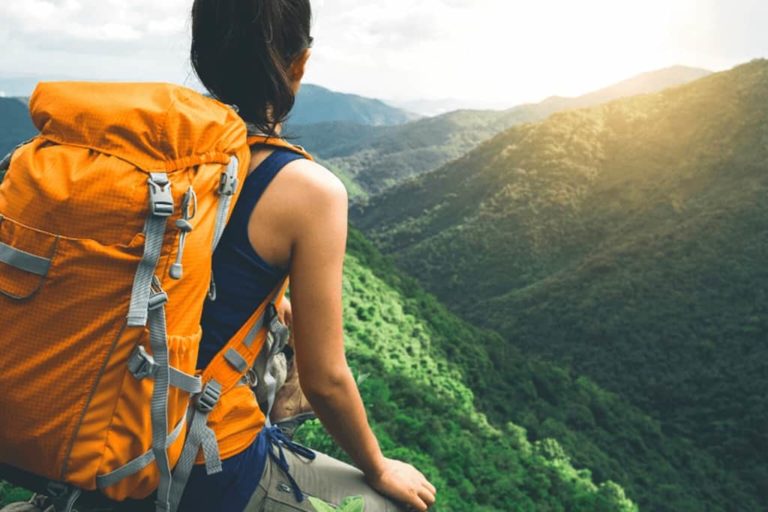A guide on trekking pants
Trekking pants are a particular type of pants made for trekking through the bush, climbing mountains, or in general, being outdoors. They’re usually made from a rigid material that is both water and bug-resistant while still managing to be lightweight and breathable.
It’s not impossible to find other types of clothing that would work just as well for hiking, but more often than not, you’ll find what you need in a pair of trekking pants.
You might also be interested in how to choose sleeping pads.
When you go trekking, you will need trekking pants. There are many, many pants out there, but not all pants are good at trekking. Some pants are good at trekking but not at other things.
So how do you find the pants that are good at trekking and good at other things?
The first thing to do is think about what you are going to be doing in these pants. How often will you be wearing them? Are they for everyday wear or special occasions? Will you be hiking, backpacking, or just walking to the toilet? What kind of terrain will you be on? Finally, what are your personal preferences? What feels best on your legs, what looks best on you, what are your legs like?
So without further delay, let us get in-depth on how to choose trekking pants.
Types of trekking pants
Before you start shop-hopping for your trekking pants, check what type of trekking pants do you want. There are three types of trekking pants such as:
- Convertible Hiking Pant: The Convertible Hiking Pant features a zip-off, convertible pant leg, which converts into shorts. The pants have an adjustable waist for custom fit and comfort. They are 100% Nylon with polyester lining and are machine washable.
- Good Old Fashioned (GOF) Hiking Pant: The Good Old Fashioned Hiking Pant features a cinched waist and an elastic waistband to provide a secure and comfortable fit. A zip fly closure, drawcord inseam, and top zipper for ventilation. It has 100% nylon inner with polyester outer shell fabric which is a quick-drying fabric.
- Roll-up Hiking Pants: The Roll-up Hiking Pant features a zip-off, convertible pant leg, which converts into shorts. It features two front slash pockets with a zippered security pocket inside the right front pocket, an elasticized waist with cord locks. The roll-up pant leg can be rolled up and secured via snap closure.
13 things to think about before buying trekking pants
1. Think about what activity you are going to carry out in them
One of the biggest mistakes people make when choosing their trekking pants is just going for the “biggest and baddest” pants they can find. You want to think about what you’re going to be doing with these pants, particularly if you’re going to be hiking or backpacking.
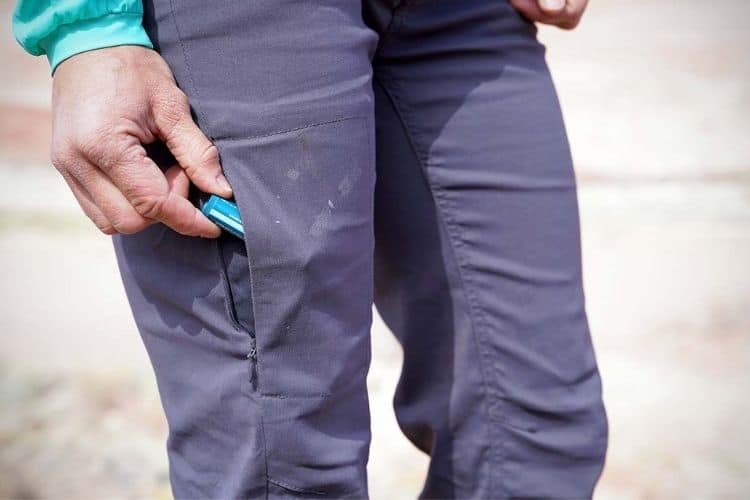
If you hike often, then go for something that can stand up to all kinds of weather and type of terrain. If you’re hiking around on trails, don’t get anything that will keep you warm in the winter. Remember, your pants are there for a reason, and it’s not just to look good.
Now, if you’re hiking or backpacking long distances, then you’re probably going to want something different. It would help if you had something that can handle a lot of abuse. You’re going to want something durable, lightweight, and comfortable. Usually, this takes the form of synthetic fabrics because they tend to be waterproof and warm.
Either way, it’s good to think about how you’re going to be using your pants before you go shopping for them. You don’t want to get something great at hiking and backpacking on the Appalachian trail but can’t handle a hike in the Smoky Mountains.
2. Think about your preferences
If you’re in the market for a new pair of pants, then it’s imperative to make sure that you’re comfortable. There’s nothing worse than going to buy a pair of pants and finding out that they don’t fit properly. What you want to do is look at what feels the most comfortable for you.
Now, a lot of times, that’s going to be the tightest pants you can find. Of course, your legs will be doing a lot of work, and it’s natural for your leg muscles to get sore. However, you shouldn’t wear something that is uncomfortably tight. If you wear pants that are too tight, then they’re going to restrict the amount of blood flow you get throughout your legs which can cause severe damage to your legs and lead to a condition known as compartment syndrome.
If you’re wearing outdoorsy pants, you want to make sure that they aren’t too loose and will be comfortable for what you’re doing. If it’s winter, then there’s probably no point in getting something lightweight because it’s just going to get wet and heavy anyhow. The same thing goes for the summer months. If you’re going to be hiking in the desert and it’s a hundred degrees, then there’s no point in getting anything that’s going to make you sweat.
3. Always buy quality
If you buy a poor-quality pair of pants, then they’re just going to rip on the first branch they hit.
Of course, no one wants that, so you should make sure that your new pants are up for the task. There’s a lot of different fabrics that are designed for hiking and backpacking. Some of the most popular materials include, but are not limited to Cotton, Polyester, Nylon (with abrasion-resistant layers), and Wool.
These materials are the most common because they’re generally lightweight, breathable, durable, comfortable, and relatively cheap to produce. You can also get other materials such as cotton canvas which is both durable and breathable. You can get a nylon ripstop, which is very strong but lightweight. There are also things like Gore-Tex, which is waterproof.
These materials are all going to hold up well in the outdoors, but some fabrics are better than others. For instance, C3 Gore Windstopper Pants is water-resistant nylon and feels very durable and breathable. However, it’s heavier and more expensive.
4. What kind of material should you choose?
Trekking Pants should be lightweight to enhance airflow while hiking in hot weather conditions. The fabric should be breathable to help maintain body temperature at an optimum level for an easy hiking experience. Below are some of the fabrics that make trekking pants:
- 100% Nylon: This is the lowest nylon density and is ideal for warm to hot weather. It is very lightweight and somewhat translucent. Its breathability makes it a great choice for warmer months but can become breezy when the temperatures drop. Thinner nylon pants are usually more comfortable in warmer months.
- 97% cotton / 3% spandex: Breathable and quick drying. This material is a great option for warmer months. It can be lightweight and very comfortable. If the cotton/spandex blend pants are 100% cotton, they should be washed cold with like colors to prevent fading or shrinking.
- Polyester: Breathable and quick drying. This material is great for year-round wear because it allows the skin to breathe well. They are lightweight but may also be breezy in cooler months. Polyester pants dry faster than cotton.
5. Weight of trekking pants
Trekking pants need to be lightweight, comfortable, and breathable for comfort during hiking. Getting the balance of these factors is essential because a heavy pair of hiking pants will weigh you down and make you uncomfortable.
Besides, since trekking pants are made of moisture-wicking fabrics, they will be more prone to absorbing sweat and following it around your body. It makes trekking pants less breathable.
Here are some strategies that can help you get the right weight for your hiking pant:
- Pick light fabrics such as cotton, polyester, and nylon. The lighter the fabric, the lighter the pants.
- Get short-length hiking pants because they have less material than regular-length hiking pants.
- Buy trekking pants that are not too baggy to reduce the weight and bulkiness of the clothing. A lot of excess material may weigh more than you expect!
- Trekking pants are ideal for going through streams when hiking. The weight of these outings tends to increase the amount of water your pant will absorb.
- If you plan on frequent hiking trails near water sources, then you may want to avoid light trekking pants and go for more robust options that are less prone to absorbing moisture.
- Hiking pants explicitly designed for hiking are best for long trips and have better moisture-wicking abilities.
6. Breathability
Trekking pants might not even be for you if you are a city dweller. But if they are, then breathability is a crucial consideration. In terms of design, this means both the fabric and the pants themselves. Breathability is the property of a fabric that allows moisture vapors to pass through.
Your trekking pants need to have breathable fabric that allows perspiration to escape and air to move freely through the fabric for the cooler seasons.
The good news is that you will not need heavy-duty trekking pants for your treks. So you can still get lightweight pants made out of durable material like nylon or polyester and have them be breathable enough for your needs.
7. Is your trekking pant water-resistant/waterproof?
If you’re planning to do some outdoor or water-related activity in the near future and you don’t care a lot about how your trousers look, these are perfect pants for you. Waterproof pants are made from durable nylon that is designed to withstand water, even the waist might be waterproof.
These pants are also designed to keep you dry while you hike through water bodies like rivers and streams. But if you need something that will keep you dry even in a heavy downpour, then go for a pair of hiking pants that can repel water.
These pants are also breathable, so they can easily handle hot and humid weather conditions and help prevent sweat accumulation because they are very breathable.
If you plan to do a lot of hiking, for instance, in freezing temperatures, then waterproof trekking pants are not for you. However, if you intend to use these pants for water sports and such activities that don’t involve a lot of trekking or hiking while in water-bodies, then these are the way to go.
Water-resistant materials:
- Lightweight material: It quickly wicks moisture away from the skin surface; however, it doesn’t repel water very well. The material tends to be thin and somewhat translucent, so you might want to consider wearing some lightweight synthetic underwear underneath if you plan to spend time in the snow or on wet surfaces.
- Medium-weight fabric: It does an excellent job of resisting moisture and repelling water to protect you from the elements. It is used in various activities such as hiking, climbing, cycling, snow sports, and paddling.
- Very dense/heavy material: It is tightly woven and highly water-resistant. This material does not breathe well, so that it may be best for the drier periods of the year or low activity levels. It is an excellent option for hiking in the snow.
8. Is your trekking pant windproof?
Most of the time, people confuse windproof pants with waterproof pants because both keep you dry. However, the two are very different from each other. While waterproof pants will keep you dry by preventing water from entering your pants, windproof pants will keep your legs warm by preventing them from getting cold and slowing down heat loss.
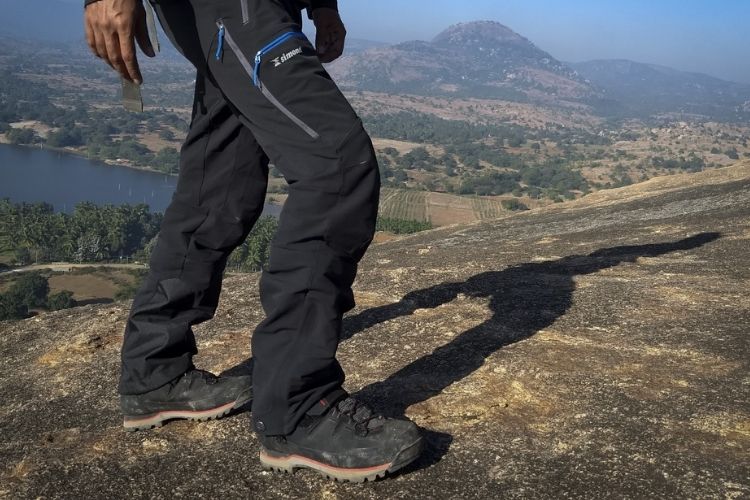
These pants are made of two heavyweight layers and a windproof membrane between the two layers to protect against cold drafts.
If you plan to use these trousers for winter activities like hiking or camping, you should look for the stuff that is lightweight and breathable, while the inner layer of the pants is made of waterproof material.
So when it comes to choosing between water-resistant and windproof pants, you need to consider your activity level, how much you are planning to spend on waterproof pants vs. windproof pants, and which environment you plan on using them in.
9. Quick dry
Quick-dry, dry-fit trekking pants, and shorts are designed to dry fast. They are made of synthetic fabrics such as polyester, nylon, or rayon that keep your body dry and comfortable. These fabrics can be used in all weather conditions, from cold to hot or wet to dry, providing an extra layer of protection against the wind, rain, and hot days.
Quick-dry fabrics are lightweight and thin but wick moisture away from your skin. They are perfect for high-output activities in cold, wet conditions and make good mid-layer insulation in cold weather.
When choosing between quick-dry pants or regular waterproof trekking pants, you need to consider how much time you have in between activities and how long it takes for the pants to get dry. It is advisable to choose quick-dry pants for activities where you might be waiting overnight. There are also many quick-dry shirts available.
10. UPF (Ultraviolet Protection Factor)
The UPF (Ultraviolet Protection Factor) is a rating system that measures how much UV radiation will penetrate the fabric. It considers both the fabric’s ability to block UV radiation and the width and weight.
Anything above a UPF of 30 is recommended. A large-scale study done on UV protection found that trekking pants block UV radiation with a rating of UPF 44, meaning they block 98% of the UV radiation. If you plan to hike in the mountains or outdoors in the sun for a long time, then you would be wise to pick pants with a UPF rating of 30 or higher. The higher the number, the greater the protection.
11. Bug Resistance
The problem of insect bites is often encountered in areas that are rich in vegetation and near water. It is because mosquitos and other insects find the salty sweat from people who are working or playing in these environments to be a tasty food source.
Insect bites can be painful and vulnerable in skin rashes resulting from high temperatures, lack of proper protection, or simply from the use of extra-large clothing for warmth.
When choosing trekking pants, it is essential to pay attention to the level of protection against insects on your next hike or camping trip. If you are going to spend a lot of time outdoors during the summer months, there is no excuse for not bringing along some bug repellent.
Even if you do use bug repellent, it is recommended that you wear light-colored clothing because many chemicals darken when they come into contact with the sun. Light-colored pants will not attract them if you are going to use insect repellent.
If you notice that you have an insect hole or bee stinger, then the simplest thing to do is press it against your pants and choose a different place to consider. The goal here should be to prevent infection and swelling because some insects have bacteria in their mouth that prolong the healing process and leads to infections.
12. Additional features of trekking pants to think about
- Attached belts
Let’s talk about the pros and cons of attaching belts to trekking pants. Some people prefer this idea because it is an excellent way to keep the pants steady when either sitting or bending. There is also a little extra room to store small things that you may need.
However, if you plan to hike and camp in the jungle, I would recommend not attaching any belt/s as there will be a lot of swinging and rough contact with trees during hiking or walking. The belts can also cause damage to the pants/suit since they will rub against the trees.
- Elastic Waist Belts
Like attaching belts, elastic waist belts are a good idea for people who have had previous injuries in the abdominal area. If you choose to use or wear this piece of equipment, it is essential to securely fasten it and check that you have adjusted it correctly. It will prevent accidents and ensure safety.
There are, of course, a lot of things to consider when purchasing and wearing elastic belts. It is essential to know the purpose before you go out and buy one. If you are going on a camping or hiking trip, I would recommend using one as there will be many activities that will require bending and stretching.
There can be a lot of problems that can occur when wearing elastic waist belts. These include skin rashes or chafing, often when you have not used the proper size or product. The belt also rubs against the pants causing small holes and rips to appear on them due to friction.
- Pockets
Pockets are convenient and allow quick access when needed. Pockets have always been an essential part of backpacking clothing, and they have become even more critical in lightweight backpacking clothing.
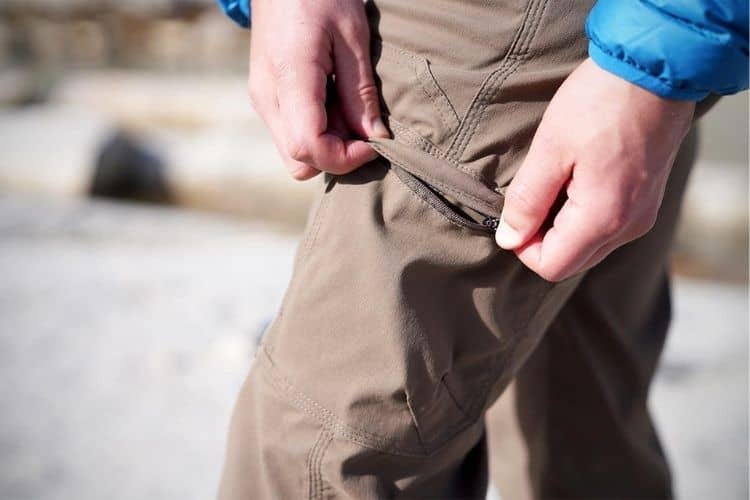
The trousers pockets can be with or without zips, lateral or on the thigh and back of the leg. There are usually side pockets or front pockets. There is the main pocket and small pockets for storing things like wallets or mobile phones.
Pockets are easy to wear when you are going for a walk or hiking in the woods because you can store things like maps, books, pens, mobile phones, torches, and more.
Pockets on the thigh tend to be significant, and they have been popular with hunters due to their utility. They also provide easy access and extra space to store things.
13. Price
There are a lot of considerations you will have to make when choosing trekking pants. One of the most important ones is your price range. For this reason, you will need to do your homework before making a purchase online or even offline.
Read 10 awesome tips on trekking for beginners.
The more expensive trekking pants tend to have better quality and may last longer compared to cheaper products. You can also use them for other purposes such as camping, hiking, and backpacking.
To help you choose the best pair of hiking pants, there are some features and considerations that you will need to take into consideration when buying them like the average weight, quality, features, and whatnot of pants.
The average weight of trousers in pounds and kilograms/lb kgs is 1.6kg – 3.5kg/3-9lbs-7lbs.
If you want to know the average weight of your trousers in pounds and kilograms, you will need to measure the pants’ waist and length.
Generally, hiking pants are medium-heavy and provide excellent ventilation against moisture while hiking. They should be made with either lightweight or durable material that is water-repellent.
Most expensive lightweight hiking pants have reinforced seams that provide comfort and support when you are trekking or hiking.
Taking care of trekking pants
Taking care of trekking pants is easy when the material is made of durable fabric like nylon. The first thing to do after washing or a long day out on the trail is to hang them up and let them air dry. Pull them inside out to wash them. If the pants have zippers, be sure to close and secure the zippers before washing.
Never put your trekking pants in the dryer, and never wring them out! Placing your trekking pants on hangers will ensure they get air all around them and let them dry faster.
Best trekking pants 2021
PrAna Stretch Zion
When performance meets comfort, prAna Stretch Zion is formed. Yes, this 97% nylon and 3% spandex pant has a stretchable fabric that helps you move comfortably.
It has got cargo pockets and a waistband adjuster. It is durable and can be worn for snowshoeing as well.
Kuhl Renegade Convertible
This trekking pant is by far the best convertible trekking pant. With 95% nylon and 5% spandex, it is durable and has a zip-off design. It is slightly baggy but has a low-profile styling that disguises the zippers.
Kuhl Renegade Convertible offers a lot of storage options with its standard two front pockets, rear pockets, and a cargo pocket at both sides of the pant.
Montane Terra Pack
Montane Terra Pack is a stretchable nylon trekking pant that is ultralight and breathable. It has a removable belt and has an athletic cut that provides comfort while moving fast on the trails. Not to mention, these pants are water and windproof.
Thus, there are many different varieties of types and colors of trekking pants that you can choose from. There are many different models and styles that you can pick depending on your purpose. For example, light and airy cotton pants will make your skin look radiant, but they also don’t perform well in hot times because they will get uncomfortable when hiking or walking in hot environments.
Some people prefer to wear the breathable one because it provides excellent ventilation to sweat a lot when it’s scorching. In the end, you should choose trekking pants that will cater to your needs when you are traveling and hiking.

